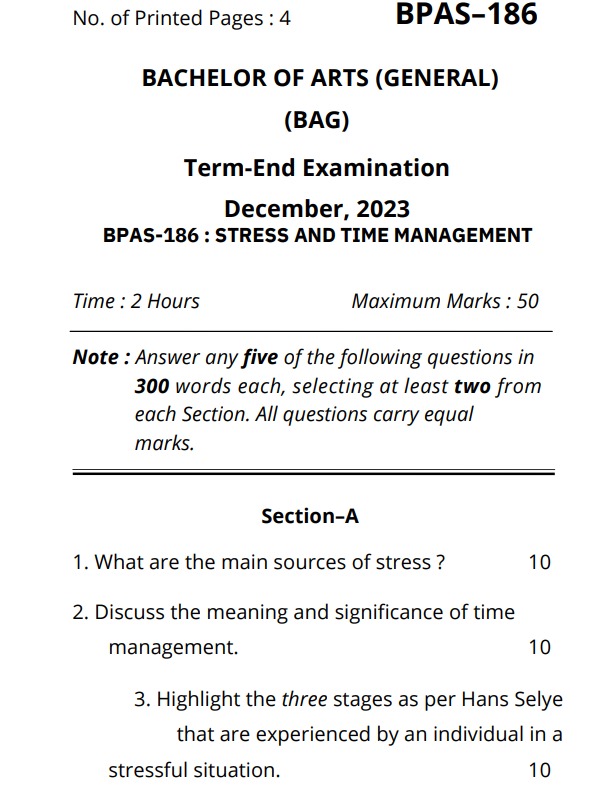Introduction of BPSC 112 Question Paper.
The BPSC 112 question paper represents a pivotal thing in the journey towards modernizing police forces in India. Developed via the Bureau of Police Research and Development, this comprehensive exam assesses applicants’ information of the vital reforms and strategies proposed within the BPAS 112 report.
The query paper demanding situations aspirants to engage with numerous components of police modernization, from the combination of advanced technology to the overhaul of schooling packages and policy frameworks. It evaluates their ability to apply theoretical understanding to practical situations, preparing them to cope with the evolving challenges faced by way of cutting-edge regulation enforcement agencies.
Through the BPSC 112 question paper, candidates delve into the strategic priorities highlighted within the record. They discover solutions for boosting police efficiency, accountability, and public trust even as thinking about the nuances of maintaining regulation and order in a dynamic society. This exam fosters essential thinking and strategic evaluation, vital skills for destiny police leaders devoted to imposing modern reforms.
In essence, the BPSC 112 question paper is greater than an assessment tool; it’s far a gateway to expertise and embracing the transformative adjustments essential for effective policing. It equips aspirants with the knowledge and insights needed to force ahead the imaginative and prescient of a current, responsive, and accountable police pressure in India
Download From Here
| YEAR | Links |
|---|---|
| Download BPSC-112 Question Paper | Click Here |

Structure of the Question Paper
The structure of the BPSC 112 question paper is designed to comprehensively assess candidates’ knowledge and understanding of modern policing strategies and reforms. Below is an outline of a typical structure:
Section A: Multiple Choice Questions (MCQs)
- Number of Questions: 20-30
- Marks: 1 mark each
- Focus: Basic concepts, factual knowledge, and understanding of key recommendations in BPAS 112.
Section B: Short Answer Questions
- Number of Questions: 5-10
- Marks: 5 marks each
- Focus: Briefly explain concepts, provide definitions, and outline strategies related to police modernization.
Section C: Case Studies/Scenario-Based Questions
- Number of Questions: 2-3
- Marks: 10-15 marks each
- Focus: Application of theoretical knowledge to practical situations. Analyze given scenarios, propose solutions, and demonstrate problem-solving skills.
Section D: Essay-Type Questions
- Number of Questions: 2-3
- Marks: 20 marks each
- Focus: In-depth analysis of key topics. Discuss reforms, evaluate policies, and critically analyze aspects of police modernization.
Section E: Data Interpretation and Analysis
- Number of Questions: 2-3
- Marks: 10 marks each
- Focus: Interpret graphs, charts, and data related to crime statistics, resource allocation, and other relevant metrics. Provide insights and recommendations based on data.
Section F: Policy Review and Recommendations
- Number of Questions: 1-2
- Marks: 15-20 marks each
- Focus: Review current policies, propose new initiatives, and discuss the impact of recommended changes on policing practices.
General Guidelines:
- Total Marks: 100-150 marks
- Duration: 3 hours
- Instructions: Candidates are expected to answer all questions in a clear and concise manner, providing well-structured and supported arguments where necessary.
Evaluation Criteria:
- Knowledge and Understanding: Demonstrated grasp of key concepts and recommendations in BPAS 112.
- Analytical Skills: Ability to analyze scenarios, interpret data, and provide logical solutions.
- Critical Thinking: Ability to critically evaluate policies and suggest improvements.
- Clarity and Coherence: Clear presentation of ideas and structured responses.
Difficulty level analysis
The BPSC 112 question paper covers a range of key topics related to police modernization and reforms as outlined in the BPAS 112 report. Here are the main topics typically addressed:
1. Technology Integration in Policing
- Key Areas: Use of modern technology in crime prevention and investigation, adoption of digital tools, cybersecurity measures.
- Examples: Body-worn cameras, forensic technology, predictive policing software.
2. Training and Capacity Building
- Key Areas: Enhancements in police training programs, skill development, continuous professional education.
- Examples: Inclusion of modern policing techniques, psychological training, disaster management training.
3. Infrastructure and Resource Management
- Key Areas: Upgrading police infrastructure, optimal resource allocation, modernizing police stations.
- Examples: Facilities for forensic labs, communication systems, transport and mobility solutions for police forces.
4. Policy and Legal Reforms
- Key Areas: Legislative changes to support police reforms, policy updates, compliance with human rights standards.
- Examples: Police accountability measures, community policing policies, legal framework for technology use.
5. Community Policing and Public Engagement
- Key Areas: Strategies to enhance public trust, community engagement initiatives, collaboration with local organizations.
- Examples: Community outreach programs, public awareness campaigns, partnerships with civil society.
6. Ethics and Accountability in Policing
- Key Areas: Ethical standards for police conduct, mechanisms for accountability, transparency in policing operations.
- Examples: Independent oversight bodies, internal audit systems, anti-corruption measures.
7. Crisis and Disaster Management
- Key Areas: Preparedness for natural and man-made disasters, emergency response protocols, coordination with other agencies.
- Examples: Disaster response training, inter-agency collaboration during crises, public safety during emergencies.
8. Crime Prevention and Investigation
- Key Areas: Modern methods for crime detection and prevention, investigative techniques, use of data analytics.
- Examples: Intelligence-led policing, crime mapping, data-driven strategies for crime reduction.
9. Human Resource Management in Police Forces
- Key Areas: Recruitment and retention strategies, performance evaluation, welfare of police personnel.
- Examples: Merit-based recruitment, career development programs, mental health support for police officers.
10. International Practices and Comparative Analysis
- Key Areas: Learning from global best practices, adapting international strategies to local context.
- Examples: Comparative study of policing models, international cooperation in crime prevention.
11. Challenges and Opportunities in Police Modernization
- Key Areas: Identifying barriers to modernization, exploring opportunities for innovation.
- Examples: Resistance to change within the police force, funding challenges, emerging technological solutions.
12. Implementation and Impact Assessment of Reforms
- Key Areas: Strategies for effective implementation of reforms, monitoring and evaluation of impact.
- Examples: Setting up task forces, regular impact assessment reports, feedback mechanisms.
Key Topics Covered
The BPSC 112 query paper encompasses a complete range of key topics associated with police modernization and reforms as highlighted inside the BPAS 112 document. Here are the main topics typically blanketed:
1. Technology Integration in Policing
Key Areas: Adoption of modern era for crime prevention, investigation, and ordinary police work.
Examples: Implementation of body-worn cameras, use of forensic era, deployment of predictive policing software program, improvements in cybersecurity measures.
2. Training and Capacity Building
Key Areas: Reforms in police schooling programs to enhance talents and abilities.
Examples: Incorporating contemporary policing strategies, mental training, non-stop professional development, disaster management training.
3. Infrastructure and Resource Management
Key Areas: Upgrading police infrastructure and optimizing useful resource allocation.
Examples: Modernizing police stations, enhancing communique structures, enhancing forensic lab centers, ensuring adequate mobility answers for police forces.
4. Policy and Legal Reforms
Key Areas: Legislative and coverage adjustments to guide and beautify police reforms.
Examples: Enacting measures for police accountability, updating community policing policies, legal frameworks governing era use in policing.
Five. Community Policing and Public Engagement
Key Areas: Strategies to enhance public consider and engage with communities successfully.
Examples: Community outreach programs, public consciousness campaigns, partnerships with nearby organizations, projects to foster police-network collaboration.
6. Ethics and Accountability in Policing
Key Areas: Establishing moral standards and making sure duty inside police forces.
Examples: Independent oversight bodies, internal Audit systems, anti-corruption measures, transparency initiatives.
7. Crisis and Disaster Management
Key Areas: Preparedness and response techniques for natural and guy-made failures.
Examples: Emergency reaction protocols, coordination with different companies, education for catastrophe scenarios, public safety measures throughout crises.
Eight. Crime Prevention and Investigation
Key Areas: Modern strategies for detecting, stopping, and investigating crimes.
Examples: Intelligence-led policing, crime mapping, use of statistics analytics, proactive crime prevention strategies.
9. Human Resource Management in Police Forces
Key Areas: Strategies for recruitment, retention, and welfare of police employees.
Examples: Merit-based totally recruitment, career development applications, intellectual health help for law enforcement officials, overall performance assessment structures.
10. International Practices and Comparative Analysis
Key Areas: Learning from worldwide great practices and adapting them to local contexts.
Examples: Comparative research of global policing fashions, global cooperation in crime prevention, adoption of successful worldwide strategies.
11. Challenges and Opportunities in Police Modernization
Key Areas: Identifying and addressing boundaries to modernization and exploring new possibilities.
Examples: Overcoming resistance to change, securing funding for reforms, leveraging emerging technologies for police work.
12. Implementation and Impact Assessment of Reforms
Key Areas: Strategies for successfully imposing reforms and comparing their effect.
Examples: Setting up challenge forces, accomplishing regular effect assessments, remarks mechanisms, monitoring and assessment systems.
Effective Preparation Strategies
Preparing effectively for the BPSC 112 question paper requires a strategic technique that balances complete information, utility, and evaluation of key topics. Here’s an in depth instruction method:
1. Understand the Syllabus and Exam Pattern
Review Syllabus: Thoroughly apprehend the key subjects and subtopics blanketed inside the BPAS 112 file.
Exam Pattern: Familiarize your self with the structure of the query paper, together with the types of questions (MCQs, brief answer, essay, case research, and so forth.) and their weightage.
2. Create a Study Plan
Set Goals: Break down the syllabus into practicable sections and set clean, workable study desires.
Timetable: Develop a take a look at timetable that allocates unique time slots for each topic, making sure balanced insurance of all regions.
Consistency: Maintain a consistent observe habitual, fending off ultimate-minute cramming.
3. Comprehensive Reading and Note-Taking
Primary Sources: Study the BPAS 112 report in element. Pay attention to pointers, case studies, and examples furnished.
Supplementary Materials: Use additional books, articles, and online sources to benefit deeper insights into key topics.
Notes: Take concise, organized notes highlighting critical factors, definitions, and examples. Create thoughts maps and summaries for brief revision.
4. Focus on Key Topics
Technology Integration: Understand the position of era in present day policing, including particular gear and their programs.
Training and Capacity Building: Study numerous education packages and their impact on police efficiency.
Policy and Legal Reforms: Review current guidelines, proposed reforms, and prison frameworks assisting modernization.
Community Policing: Explore techniques to decorate public accept as true with and engage with communities successfully.
CONCLUSION
In end, preparing for the BPSC 112 question paper, which focuses on police modernization and reforms as mentioned within the BPAS 112 report, needs a complete and strategic approach. Understanding the syllabus, structuring a observe plan, and focusing on key topics which includes era integration, training reforms, coverage enhancements, and network policing are crucial.
Effective training involves diligent observe of number one and supplementary substances, everyday practice with mock exams and former yr papers, and honing analytical and application-based totally abilities through case research and essay writing. Staying updated with contemporary affairs in law enforcement and keeping typical nicely-being are equally critical components of readiness for the exam.
By adopting those strategies and keeping consistency in education, applicants can decorate their knowledge, essential questioning capabilities, and readiness to make a contribution successfully to the evolving panorama of policing in India. This holistic approach no longer handiest prepares them for the BPSC 112 examination but also equips them to cope with the demanding situations and possibilities in modernizing police forces across the country.
FAQS for BPSC 112 Question Paper
1. What topics should I focus on for the BPSC 112 question paper?
Key topics include technology integration in policing, training and capacity building, infrastructure and resource management, policy and legal reforms, community policing, ethics and accountability, crisis and disaster management, crime prevention and investigation, human resource management, international practices, challenges and opportunities in police modernization, and implementation and impact assessment of reforms.
2.How is the BPSC 112 question paper structured?
The question paper typically includes:
- Multiple Choice Questions (MCQs) to test basic knowledge.
- Short Answer Questions for concise explanations of concepts.
- Case Studies/Scenario-Based Questions to apply theoretical knowledge.
- Essay-Type Questions for in-depth analysis and critical thinking.
- Data Interpretation and Analysis for logical reasoning and drawing conclusions.
- Policy Review and Recommendations to evaluate and suggest improvements.
3. How can I effectively prepare for the BPSC 112 question paper?
Effective preparation involves:
- Understanding the syllabus and exam pattern.
- Creating a study plan with specific goals and a consistent timetable.
- Comprehensive reading and note-taking from primary and supplementary sources.
- Focusing on key topics and practicing application-based questions.
- Taking mock tests and solving previous year papers.
- Engaging in group study and discussions.
- Staying updated with current affairs.
- Regularly reviewing and revising notes.
- Maintaining health and well-being.
4. How important are mock tests and previous year papers?
Mock tests and previous year papers are crucial for understanding the exam pattern, improving time management, and identifying areas needing improvement. They help simulate real exam conditions and build confidence.
5. How can I improve my essay writing skills for the exam?
Practice writing essays on key topics, focusing on structure, clarity, argumentation, and critical analysis. Read sample essays and seek feedback from peers or mentors to improve your writing.




















